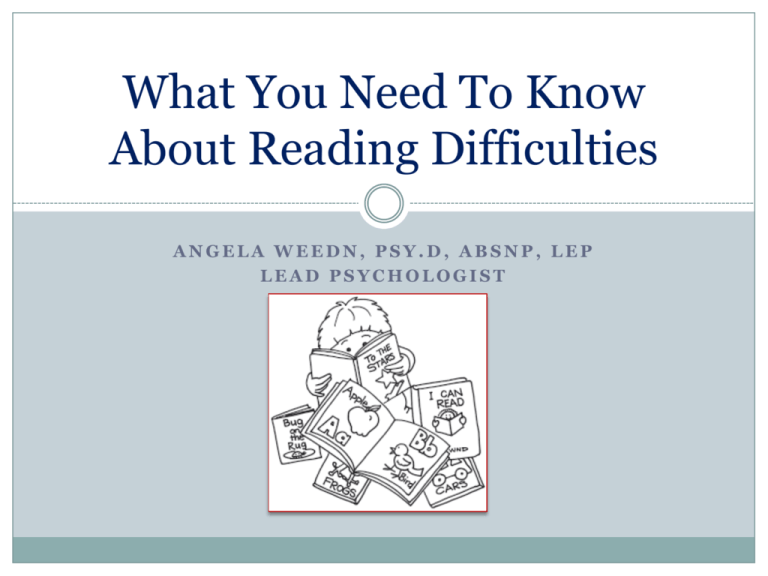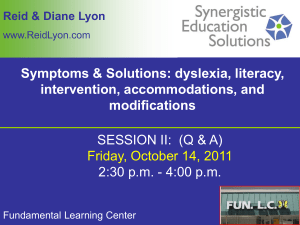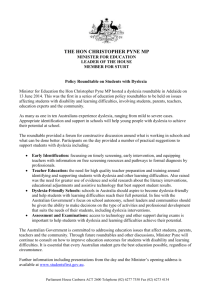Profiling Reading Difficulties
advertisement

What You Need To Know About Reading Difficulties ANGELA WEEDN, PSY.D, ABSNP, LEP LEAD PSYCHOLOGIST The 3 Parts to Reading Decoding Sounding out a word using sound-symbol correspondence Fluency The rate and accuracy of reading Comprehension Understanding the content of what is being read What Causes Reading Difficulties? 1) PHONOLOGICAL PROCESSING DEFICITS 2)ORTHOGRAPHIC PROCESSING DEFICITS 3)COMPREHENSION DEFICITS Phonological Processing Deficits Core problem in the phonological processing system of oral language. Obvious trouble learning sound-symbol correspondence, sounding out words, and spelling. Trouble with accurate and fluent word recognition Often occurs in combination with fluency and comprehension problems. 70-80% of poor readers have this type of deficit. *See handout entitled, “Developmental Sequence of Phonological Processing” Orthographic Processing Deficits Specific weaknesses with speed of word recognition and automatic recall of word spellings, although they do relatively well on tests of phoneme awareness and other phonological skills. Appear to be accurate but too slow in word recognition and text reading. Trouble developing automatic recognition of words by sight and tend to spell phonetically but not accurately. Generally has milder difficulties with reading than students with phonological processing deficits. 10-15 percent of poor readers have this type of deficit Comprehension Deficits Appear to decode words better than they can comprehend the meanings of passages. Can read words accurately and quickly and they can spell. problems are caused by disorders of social reasoning, abstract verbal reasoning, or language comprehension. 10-15% of poor readers have this type of deficit Wait! What about Dyslexia? DYSLEXIA: A MOVING TARGET Developmental Dyslexia Learning Disabilities Reading Disorders Dyslexias Subtypes What is Dyslexia? Current Definition by International Dyslexia Association (2002) “Dyslexia is a specific learning disability that is neurobiological in origin. It is characterized by difficulties with accurate and/or fluent word recognition and by poor spelling and decoding abilities. These difficulties typically result from a deficit in the phonological component of language that is often unexpected in relation to other cognitive abilities and the provision of effective classroom instruction. Secondary consequences may include problems in reading comprehension and reduced reading experience that can impede growth of vocabulary and background knowledge.” 3 Subtypes of Dyslexia Dysphonetic Dyslexia Surface Dyslexia Mixed Dyslexia Dysphonetic Dyslexia Great difficulty using phonological route in reading, so visual route is used. These readers do not rely in letter to sound conversions, but rather overrely on visual cues to determine meaning from print. Surface Dyslexia Over-reliance on sound symbol relationships as the process of reading never becomes automatic. These children break every word down to its phonetic base, and read slowly due to poor orthographic processing. WORD READ AS island → izland grind → grinned listen → liston begin → beggin lace → lake Extreme difficulty reading words where phonemes and graphemes are not 1:1 correspondence: yacht debt Mixed Dyslexia Severely impaired readers with characteristics of both phonological deficits, as well as orthographical deficits. These readers have no usable key to the reading and spelling code. Very bizarre error patters are often observed. WORD advice correct violin museum possession material READ AS exvices corex vilen musune persessive mitear There are multiple breakdowns along many cognitive pathways modulating the entire reading process What is Dyslexia? If my child has dyslexia, will they qualify for special education? …MAYBE • Approximately half of all students in special education are identified as being learning disabled (not necessarily dyslexic) • As many as 20% of the entire general education population may be dyslexic Reasons why students who are dyslexic may not qualify for special education Certain subtypes of dyslexia do not always have a significant education impact (statistically significant underachievement compared to general population to qualify as having specific learning disability). Some students with dyslexia have learning difficulties that do not reach disability threshold and can be addressed with intervention within general education. *It’s important to note that a learning disability should not be viewed as a disease model of interpretation- meaning that a student either has “it”, or does not have “it”. There are degrees of differences in learning each child differs in how they may, or may not, compensate for weaknesses. Other Factors that Can Contribute to Reading Difficulties Other neuropsychological processing deficits including global language deficits Memory deficits Naming speed deficits These factors can cause reading difficulties but the root of the cause is a more global impact on the child’s functioning. What can I do if my child has trouble decoding? Always discuss your concerns with your child’s teacher. Your child’s struggles may be developmentally appropriate for their age. If not, discuss the appropriateness of an SST. Study sound/symbol associations with flashcards, especially diphthongs (ou, ow, ai, ea, ay, oy, oi, etc…) Car games- phoneme sequencing in chains. Start with basic vowel sounds and CV (Consonant Vowel) words and increase complexity as child is ready. (demonstration). Can also do this with colored block manipulation and blank paper with lines. Always start with real words and when that is mastered, move to nonsense words What can I do if my child struggles with fluency Choose a paragraph to read with your child that is at your child’s reading level. Prior to reading, go through and identify words your child may not be familiar with and work on sounding them out BEFORE you start reading. Immediately identify reading errors (demonstration to appropriate way to correct errors) Reread a sentence if there was a correction. Reread the paragraph at the end. Paragraph example Volunteer? Little Bear’s Friend He could hear the wind sing. And he could feel the wind on his fur, on his eyes, on his little black nose. He shut his eyes, and let the wind brush him. He opened his eyes, and saw two little squirrels. What can I do if my child is struggling with comprehension? Pick a paragraph that is at your child’s reading level and a subject matter of interest. It doesn’t have to be a chapter book. It could be ANYTHING. Ask questions at the beginning of the text to provide direction. If there are pictures- talk about them and ask for predictions. After about 30 seconds, stop and ask your child what they picture happening. Don’t let them repeat verbatim what they just read. Question to character, setting, and anything that is visual in nature. You want to encourage them to be making a visual representation in their head instead of trying to remember what they are hearing themselves read. Continue doing this for 10 minutes and then have your child retell you what they read in their own words. Things to keep in mind… Limit these extra things you do with your child to no more than 10 minutes a day, but do them at least 5 days a week. Reward them when they do these activities- their brains get tired! If it’s too hard, make it easier. You want them to do this practice but if they aren’t successful, they are likely to shut down. It’s a delicate dance. References Feifer, S.G. & Douglas, D.T. (2007). Integrating RTI with cognitive neuropsychology: A scientific approach to reading. Middletown, MD: School Neuropsych Press, LLC Moats, L. & Tolman, C. Types of Reading Disabilities. Retrieved from http://www.readingrockets.org/article/typesreading-disability QUESTIONS







